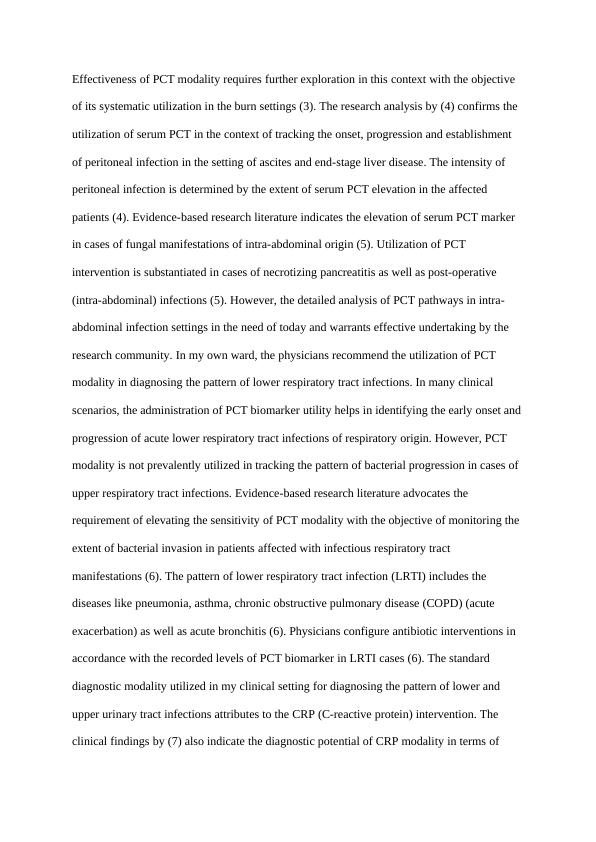Infectious Disease- Procalcitonin (PCT)
10 Pages3208 Words50 Views
Added on 2020-02-24
Infectious Disease- Procalcitonin (PCT)
Added on 2020-02-24
ShareRelated Documents
Infectious DiseasesIntroductionProcalcitonin (PCT) is a significant diagnostic tool utilized for effectively diagnosing the inflammatory conditions and associated clinical manifestations. The discrimination between the pattern of aseptic inflammation and bacterial infection is made possible with the utilization of PCT intervention (1). PCT approach is a newly invented modality that is evidentially utilized for accurately diagnosing the early onset of severe sepsis and sepsis in the patient population (2). PCT exhibits greater diagnostic specificity in terms of exploring a range of infections that the conventional biomarkers fail to discover in the laboratory settings.Although the blood culture intervention is the standard modality warranting utilization for diagnosing the establishment of bacteremia and sepsis, PCT approach assists clinicians in identifying the beginning stages of the infectious processes for taking calculated decisions in the context of administering antimicrobial therapy (2). PCT intervention helps the treating physicians in terms of undertaking calculated decisions regarding the dosage and length of administration of antibiotic therapy for enhancing the treatment outcomes. Utilization of PCTapproach in diagnosing the early onset and establishment of non-infectious manifestations is a subject of debate in the research community (2). The acquisition of an early diagnosis (related to the infectious conditions) is made possible through the systematic utilization of PCT modality and physical examination intervention with the objective of recommending goal oriented antimicrobial approaches for the suspects of septic manifestations (2). Evidence-based clinical literature affirms the adverse outcomes of the misutilization of antibiotic therapy in terms of elevated mortalities among the burn patients affected with the pattern of the initial shock (3). The inappropriate antimicrobial administration not only elevates the healthcare costs of burn patients but also elevates the pattern of their microbial resistance. Implementation of antimicrobial supervision with the systematic utilization of

PCT biomarker leads to the sustained reduction in the frequency of inappropriate antibiotic prescription, its non-systematic administration and cessation in the hospital settings (3). PCT modality proves advantageous in terms of the precise and timely tracking of the beginning of systemic infection in predisposed patients (3). The clinical study by (3) affirms the reciprocal alterations in the serum level of the PCT under the influence of the infectious progression. Similarly, PCT levels decline in accordance with the decline in the systemic infectious process under the influence of antimicrobial intervention. This signifies the role of PCT modality in influencing the determination of dosage and time of the antimicrobial infection for reducing the scope of occurrence of adverse events among the infected patients (3). Normalization of PCT biomarker value sometimes indicates the development of inflammatory processes (of non-infectious origin). Therefore, periodic assessment of the serum PCT level in the infected patients is necessarily warranted for determining their predisposition in terms of acquiring the pattern of non-inflammatory infectious processes during the length of their stay in the clinical setting (3). Utilization of PCT modality appears beneficial particularly in the late post-traumatic burn tenure that proves to be the preliminary cause of mortalities among the burn patients. The patients experience substantial risk of development of infectious processes during this tenure and therefore PCT intervention assists clinicians in the context of deploying appropriate antibiotic interventions for systematically enhancing the treatment outcomes (3). However, utilization of PCT modality in exploring theextent of deterioration of regulatory pathways in severe burn cases remains questionable. Thepotential of PCT intervention in effectively tracking the extent of cardiovascular and hydroelectric disruptions caused under the influence of enhanced vascular permeability emanating due to the release of systemic mediators in cases of burn injuries remains questionable in the medical community (3). These clinical complications result in the development of hypovolemia that becomes the leading cause of death of the burn patients.

Effectiveness of PCT modality requires further exploration in this context with the objective of its systematic utilization in the burn settings (3). The research analysis by (4) confirms the utilization of serum PCT in the context of tracking the onset, progression and establishment of peritoneal infection in the setting of ascites and end-stage liver disease. The intensity of peritoneal infection is determined by the extent of serum PCT elevation in the affected patients (4). Evidence-based research literature indicates the elevation of serum PCT marker in cases of fungal manifestations of intra-abdominal origin (5). Utilization of PCT intervention is substantiated in cases of necrotizing pancreatitis as well as post-operative (intra-abdominal) infections (5). However, the detailed analysis of PCT pathways in intra-abdominal infection settings in the need of today and warrants effective undertaking by the research community. In my own ward, the physicians recommend the utilization of PCT modality in diagnosing the pattern of lower respiratory tract infections. In many clinical scenarios, the administration of PCT biomarker utility helps in identifying the early onset andprogression of acute lower respiratory tract infections of respiratory origin. However, PCT modality is not prevalently utilized in tracking the pattern of bacterial progression in cases of upper respiratory tract infections. Evidence-based research literature advocates the requirement of elevating the sensitivity of PCT modality with the objective of monitoring the extent of bacterial invasion in patients affected with infectious respiratory tract manifestations (6). The pattern of lower respiratory tract infection (LRTI) includes the diseases like pneumonia, asthma, chronic obstructive pulmonary disease (COPD) (acute exacerbation) as well as acute bronchitis (6). Physicians configure antibiotic interventions in accordance with the recorded levels of PCT biomarker in LRTI cases (6). The standard diagnostic modality utilized in my clinical setting for diagnosing the pattern of lower and upper urinary tract infections attributes to the CRP (C-reactive protein) intervention. The clinical findings by (7) also indicate the diagnostic potential of CRP modality in terms of

End of preview
Want to access all the pages? Upload your documents or become a member.
Related Documents
Procalcitonin-guided diagnosis and antibiotic stewardship revisitedlg...
|13
|3688
|460
Article On Infectious Diseaseslg...
|12
|3302
|48
Procalcitonin Guided Diagnosis and Antibiotic Stewardshiplg...
|13
|3009
|39
